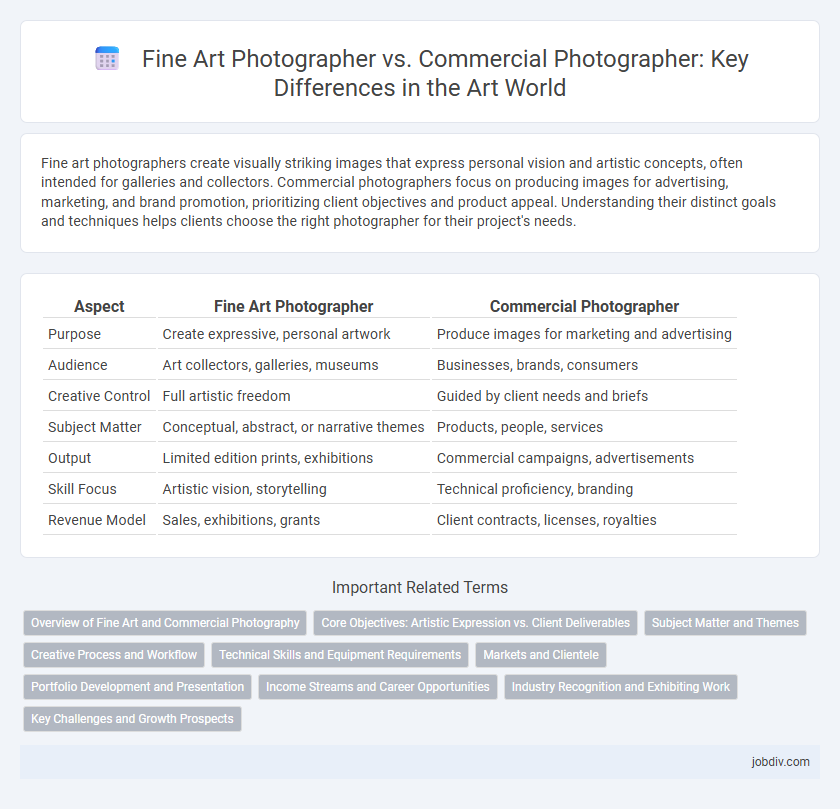Fine art photographers create visually striking images that express personal vision and artistic concepts, often intended for galleries and collectors. Commercial photographers focus on producing images for advertising, marketing, and brand promotion, prioritizing client objectives and product appeal. Understanding their distinct goals and techniques helps clients choose the right photographer for their project's needs.
Table of Comparison
| Aspect | Fine Art Photographer | Commercial Photographer |
|---|---|---|
| Purpose | Create expressive, personal artwork | Produce images for marketing and advertising |
| Audience | Art collectors, galleries, museums | Businesses, brands, consumers |
| Creative Control | Full artistic freedom | Guided by client needs and briefs |
| Subject Matter | Conceptual, abstract, or narrative themes | Products, people, services |
| Output | Limited edition prints, exhibitions | Commercial campaigns, advertisements |
| Skill Focus | Artistic vision, storytelling | Technical proficiency, branding |
| Revenue Model | Sales, exhibitions, grants | Client contracts, licenses, royalties |
Overview of Fine Art and Commercial Photography
Fine art photography emphasizes artistic expression and conceptual depth, often creating visually striking images intended for galleries, exhibitions, or private collections. Commercial photography focuses on producing images that effectively promote products, services, or brands, prioritizing clarity, appeal, and marketability. Both genres require technical expertise, but fine art photographers explore creativity and personal vision, while commercial photographers align closely with client objectives and advertising standards.
Core Objectives: Artistic Expression vs. Client Deliverables
Fine art photographers prioritize artistic expression, using imagery to evoke emotions, provoke thought, and showcase personal vision. Commercial photographers focus on client deliverables, producing images that meet specific marketing, advertising, or product needs with clear messaging. The core objective of fine art photography revolves around creativity and self-expression, while commercial photography centers on effectiveness and client satisfaction.
Subject Matter and Themes
Fine art photographers concentrate on personal expression and conceptual themes, often exploring abstract ideas, emotions, and unique perspectives through their subject matter. Commercial photographers prioritize market-driven content such as products, fashion, or corporate imagery designed to promote brands and services with clarity and appeal. Subject matter in fine art is typically open to interpretation, while commercial photography emphasizes clear, persuasive visuals aligned with client objectives.
Creative Process and Workflow
Fine art photographers prioritize personal vision and emotional expression, often spending extended periods conceptualizing and experimenting with composition, lighting, and subjects to create unique, evocative images. Commercial photographers follow a more structured workflow driven by client briefs, deadlines, and brand guidelines, emphasizing efficiency, consistency, and deliverables tailored to marketing or advertising needs. Both disciplines utilize advanced editing techniques, but fine art photographers explore creative freedom while commercial photographers prioritize meeting strategic objectives.
Technical Skills and Equipment Requirements
Fine art photographers prioritize creative expression and master advanced techniques such as long exposure, macro photography, and analog film development to capture visually compelling images that evoke emotion; their equipment often includes medium or large format cameras, specialized lenses, and darkroom tools. Commercial photographers emphasize precision in lighting, color accuracy, and post-production editing using industry-standard software like Adobe Photoshop and Lightroom, employing high-resolution DSLR or mirrorless cameras, studio lighting setups, and tethered shooting systems to meet client specifications. Both fields require a strong understanding of composition and image quality, but commercial photography demands faster workflow efficiency and consistent output, while fine art photography allows more experimental and personalized use of technical skills and equipment.
Markets and Clientele
Fine art photographers primarily target galleries, collectors, and art enthusiasts, focusing on creating visually compelling works that convey personal or conceptual narratives. Commercial photographers cater to businesses, advertising agencies, and brands, producing images designed to promote products, services, or corporate identities across various media platforms. Market demand for fine art photography revolves around exhibitions and sales, while commercial photography thrives on contracts, marketing campaigns, and mass distribution.
Portfolio Development and Presentation
Fine art photographers curate portfolios that emphasize artistic vision, originality, and emotional impact, showcasing work in galleries or exhibitions to attract collectors and critics. Commercial photographers develop portfolios tailored to client needs, highlighting versatility, technical precision, and adherence to branding guidelines for advertising or marketing campaigns. Effective presentation for fine art involves high-quality prints and contextual narratives, while commercial portfolios rely on clean, easily navigable digital displays optimized for client review.
Income Streams and Career Opportunities
Fine art photographers primarily generate income through gallery sales, exhibitions, and limited-edition prints, catering to collectors and art enthusiasts. Commercial photographers earn revenue via client contracts, advertising campaigns, product shoots, and stock photography, offering more consistent and higher-volume work. Career opportunities for fine art photographers often involve building a personal brand and reputation within art communities, while commercial photographers find diverse prospects across industries such as fashion, advertising, and media.
Industry Recognition and Exhibiting Work
Fine art photographers gain industry recognition primarily through gallery exhibitions, museum showings, and art fairs, establishing their work as collectible and culturally significant. Commercial photographers achieve recognition by securing high-profile editorial placements, advertising campaigns, and client endorsements, highlighting their ability to meet market demands. The distinction in exhibiting work lies in fine art photographers promoting limited editions in curated settings, while commercial photographers showcase portfolios in digital platforms and industry trade shows.
Key Challenges and Growth Prospects
Fine art photographers face challenges in building a unique artistic vision and securing gallery representation, while commercial photographers must consistently meet client expectations and adapt to market trends. The growth prospects for fine art photographers hinge on establishing a strong personal brand and leveraging digital platforms for exposure. Commercial photographers experience steady demand from advertising, fashion, and corporate sectors, with increasing opportunities driven by technological advancements and multimedia integration.
Fine Art Photographer vs Commercial Photographer Infographic

 jobdiv.com
jobdiv.com